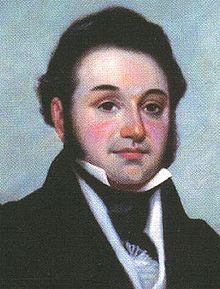Manuel Lorenzo Justiniano De Zavala, known to us historically as Lorenzo De Zavala, was born in the Village of Tecoh, near Merida, Yucatan, Mexico, on October 3, 1789. He studied in the Seminary of Ildefense, and by 1807, was an ardent liberal and advocate of domestic reforms. Because of his liberalism, he was arrested and spent some three years imprisoned in the Castle of San Juan de Ulloa. During this time he studied medicine and English.
He represented Yucatan in Spanish Cortes in Madrid, Spain, in 1820 and 1821, until he learned of the Declaration of Independence by Mexico. He was in the Mexican Senate from 1822 to 1826, and in 1827 as a Federalist, was elected governor of the State of Mexico.
During an uprising, he fled to Mexico City, participated in the Revolution of Acordada, which resulted in the election of Vicente Guerrero as President of Mexico. De Zavala was then appointed as Minister of the Treasury, while also holding onto the Governorship of the State of Mexico.On March 12, 1829, he received an empresario contract from the Mexican Government to induce five hundred families to come to Texas. This contract, on October 16, 1830, together with David G. Burnet and Joseph Vehlein, was transferred to the Galveston Bay and Texas Land Company.
In 1832, Zavala was again elected Governor of the State of Mexico. He became a member of the Mexican Chamber of Deputies in 1833 and in October of that year, was appointed Minister to France by the then President Antonio Lopez de Santa Anna.Zavala returned to Texas in July 1835 and bought a home place at what to this day is known as De Zavala Point at the confluence of the San Jacinto River and Buffalo Bayou, directly across the Bayou from the Battleship Texas.
He supported Texas Independence, represented the Harrisburg Municipality at the Consultation in 1835 and in the Convention of 1836, at Washington-on-the-Brazos, signed the Declaration of Independence. On March 16, 1836, still at the Convention, David G. Burnet was elected President of the ad interim government of Texas, and on the following day, Lorenzo de Zavala, was elected as Vice-President.Following the Battle for San Jacinto, the de Zavala home was used as a hospital for the wounded Texans, and later for wounded Mexicans. De Zavala resigned as Vice-President on October 17, 1836.
__In the following month, he and a son overturned in a boat and after saving the son, he contracted a severe cold and possibly pneumonia, and died on the 15th. He was buried in the family cemetery at the Zavala Point. In 1936, the State of Texas erected a monument at his grave.Lorenzo de Zavala Sr., had three children by his first wife, Teresa Correa of Yucatan, and three more by his second wife, Emily West of New York. Zavala County, Texas was erected on February 25, 1884, named in his honor.
 Manuel Lorenzo Justiniano De Zavala, known to us historically as Lorenzo De Zavala, was born in the Village of Tecoh, near Merida, Yucatan, Mexico, on October 3, 1789. He studied in the Seminary of Ildefense, and by 1807, was an ardent liberal and advocate of domestic reforms. Because of his liberalism, he was arrested and spent some three years imprisoned in the Castle of San Juan de Ulloa. During this time he studied medicine and English.
Manuel Lorenzo Justiniano De Zavala, known to us historically as Lorenzo De Zavala, was born in the Village of Tecoh, near Merida, Yucatan, Mexico, on October 3, 1789. He studied in the Seminary of Ildefense, and by 1807, was an ardent liberal and advocate of domestic reforms. Because of his liberalism, he was arrested and spent some three years imprisoned in the Castle of San Juan de Ulloa. During this time he studied medicine and English.






